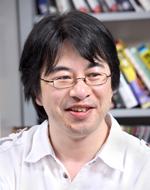2010/09/03
‚ÄúGlobal standard‚ÄĚ in computer architecture
Associate Professor Masahiro Goshima
(Department of Information and Communication Engineering)

‚ÄúHigh performance‚ÄĚ is the keyword for Associate Professor Goshima in his computer architecture research, which focuses on "core" part of high-end processors and processors for applications with high data parallelism.¬† Especially, some researchers no longer regard "core" part as a subject of research.
A processor repeats the following routine: instruction fetch, instruction decode, execute, and write-back of the result.  There are two ways to achieve higher performance, that is, to increase the frequency of the clock which runs this routine and/or to increase the number of instruction executed in a clock cycle.  Associate Professor Goshima’s approach is to balance both at a high level.
Conventional processors allocate tags for instructions to represent dependencies among them.  When an instruction is executed, the tag allocated to the instruction is broadcasted to all the subsequent instructions, then the dependent instructions which have the same tag as broadcasted one are waken up for the future executions.  Although there was no question that this tag broadcast was the only way for wake-up, the complexity of this circuit is the most significant blocking factor of the clock frequency.  Therefore, Associate Professor Goshima thought that pre-registering the dependencies among instructions as a matrix could reduce the time for wake-up.  Evaluation results show the clock speed will improve almost twice while maintaining the number of instructions executed in a clock cycle.  This idea works especially when semiconductors are miniaturized, the sizes of transistors are reduced to nanometer-order, and wire delay becomes more dominant than gate delay.
Despite the fact that Japan has made outstanding accomplishments in computer architecture, very few are globally recognized.¬† This idea, which realizes ‚Äúhigh-performance‚ÄĚ with miniaturization of semiconductors, may become a global standard.¬† The answer will be found in a few years.

